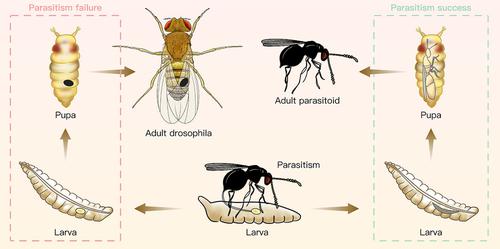当前位置:
X-MOL 学术
›
Insect Sci.
›
论文详情
Our official English website, www.x-mol.net, welcomes your feedback! (Note: you will need to create a separate account there.)
Cellular and humoral immune interactions between Drosophila and its parasitoids
Insect Science ( IF 4 ) Pub Date : 2020-08-10 , DOI: 10.1111/1744-7917.12863 Lei Yang 1 , Li-Ming Qiu 1 , Qi Fang 1 , David W Stanley 2 , Gong-Yin Ye 1
Insect Science ( IF 4 ) Pub Date : 2020-08-10 , DOI: 10.1111/1744-7917.12863 Lei Yang 1 , Li-Ming Qiu 1 , Qi Fang 1 , David W Stanley 2 , Gong-Yin Ye 1
Affiliation

|
The immune interactions occurring between parasitoids and their host insects, especially in Drosophila–wasp models, have long been the research focus of insect immunology and parasitology. Parasitoid infestation in Drosophila is counteracted by its multiple natural immune defense systems, which include cellular and humoral immunity. Occurring in the hemocoel, cellular immune responses involve the proliferation, differentiation, migration and spreading of host hemocytes and parasitoid encapsulation by them. Contrastingly, humoral immune responses rely more heavily on melanization and on the Toll, Imd and Jak/Stat immune pathways associated with antimicrobial peptides along with stress factors. On the wasps’ side, successful development is achieved by introducing various virulence factors to counteract immune responses of Drosophila. Some or all of these factors manipulate the host's immunity for successful parasitism. Here we review current knowledge of the cellular and humoral immune interactions between Drosophila and its parasitoids, focusing on the defense mechanisms used by Drosophila and the strategies evolved by parasitic wasps to outwit it.
中文翻译:

果蝇与其寄生物之间的细胞和体液免疫相互作用
寄生蜂与其寄主昆虫之间发生的免疫相互作用,尤其是在果蝇-黄蜂模型中,长期以来一直是昆虫免疫学和寄生虫学的研究重点。果蝇中的寄生虫感染被其多种天然免疫防御系统抵消,包括细胞和体液免疫。发生在血腔内的细胞免疫反应涉及宿主血细胞的增殖、分化、迁移和扩散以及被它们包裹的寄生物。相比之下,体液免疫反应更依赖于黑色化以及与抗菌肽以及压力因素相关的 Toll、Imd 和 Jak/Stat 免疫通路。在黄蜂方面,成功开发是通过引入各种毒力因子来抵消果蝇的免疫反应。这些因素中的一些或全部操纵宿主的免疫力以成功寄生。在这里,我们回顾了目前关于果蝇之间细胞和体液免疫相互作用的知识及其寄生蜂,重点关注果蝇使用的防御机制以及寄生蜂进化出的策略来战胜它。
更新日期:2020-08-10
中文翻译:

果蝇与其寄生物之间的细胞和体液免疫相互作用
寄生蜂与其寄主昆虫之间发生的免疫相互作用,尤其是在果蝇-黄蜂模型中,长期以来一直是昆虫免疫学和寄生虫学的研究重点。果蝇中的寄生虫感染被其多种天然免疫防御系统抵消,包括细胞和体液免疫。发生在血腔内的细胞免疫反应涉及宿主血细胞的增殖、分化、迁移和扩散以及被它们包裹的寄生物。相比之下,体液免疫反应更依赖于黑色化以及与抗菌肽以及压力因素相关的 Toll、Imd 和 Jak/Stat 免疫通路。在黄蜂方面,成功开发是通过引入各种毒力因子来抵消果蝇的免疫反应。这些因素中的一些或全部操纵宿主的免疫力以成功寄生。在这里,我们回顾了目前关于果蝇之间细胞和体液免疫相互作用的知识及其寄生蜂,重点关注果蝇使用的防御机制以及寄生蜂进化出的策略来战胜它。


























 京公网安备 11010802027423号
京公网安备 11010802027423号